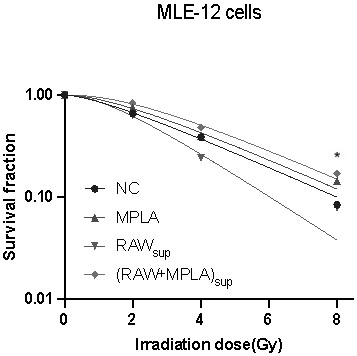Application of TLR4 excited exosome or exosome preparation in preparation of medicine for preventing and treating radiation-induced lung injury
A radiation-induced lung injury and exosome technology, applied in the field of medicine, can solve the problems of not being able to clarify the radiation protection effect of TLR4 agonists and restricting the practical application of TLR4 agonists, so as to reduce the degree of apoptosis and DNA damage, and reduce the proliferation activity Reduced, high clinical application value effect
- Summary
- Abstract
- Description
- Claims
- Application Information
AI Technical Summary
Problems solved by technology
Method used
Image
Examples
Embodiment 1
[0031] Clone formation experiments
[0032] (1) Grouping and corresponding processing methods:
[0033] Mouse macrophage RAW264.7 cells were selected and cultured in a cell incubator for 12 hours, then the culture medium was collected and collected by centrifugation as the culture medium of the RAWsup treatment group;
[0034] Select mouse macrophage RAW264.7, add MPLA (1 µg / mL) to the medium, and after culturing for 12 hours, collect the medium and collect it by centrifugation as the medium of the (MPLA+RAW) sup treatment group;
[0035] Medium plus MPLA (1µg / mL) was used as MPLA treatment group medium;
[0036] The normal control group (NC) was the untreated normal medium (DMEM medium).
[0037] (2) Experimental steps:
[0038] Four groups of different numbers of MLE-12 cells (400, 800, 1600, 3200) were cultured for 12 hours, and then the four different treatments shown in (1) were performed in each number of MLE-12 cell culture medium. , 0Gy, 2Gy, 4Gy, 8Gy were carried ...
Embodiment 2
[0041] (1) Different treatments of MLE-12 cells are the same as those in Example 1(1).
[0042] (2) The cultured MLE-12 cells were subjected to the above four treatments respectively, 0Gy and 8Gy irradiation were performed after 12 hours, the normal medium (DMEM medium) was replaced after irradiation, and the cells were cultured for 48 hours for flow cytometry apoptosis. detection, the results are image 3 and Figure 4 .
[0043] It can be seen that the (MPLA+RAW) sup treatment group significantly reduced the apoptosis of cells after irradiation compared with the other three groups, indicating that MPLA reduced the MLE after irradiation by stimulating macrophage TLR4 to stimulate the exosome preparation secreted by macrophages -12 Apoptosis.
Embodiment 3
[0045] (1) Different treatments of MLE-12 cells are the same as those in Example 1(1).
[0046] (2) The cultured MLE-12 cells were subjected to the above four treatments respectively, 8Gy irradiation was performed after 12 hours, and the cells were collected at the 0th, 1st, and 8th hours of irradiation for γ-H2AX Western Blot detection, and the results were as follows Figure 5 and Image 6 .
[0047] It can be seen that the exosome preparation produced after activation of macrophage TLR4 alleviates DNA double-strand breaks in irradiated MLE-12 cells.
[0048] All experiments in Examples 1-3 of the present invention were repeated more than 3 times, and the results were expressed as ±S. Use SPSS25.0 software statistical software to carry out t test on relevant data, with P<0.05 as a significant difference.
PUM
 Login to View More
Login to View More Abstract
Description
Claims
Application Information
 Login to View More
Login to View More - R&D Engineer
- R&D Manager
- IP Professional
- Industry Leading Data Capabilities
- Powerful AI technology
- Patent DNA Extraction
Browse by: Latest US Patents, China's latest patents, Technical Efficacy Thesaurus, Application Domain, Technology Topic, Popular Technical Reports.
© 2024 PatSnap. All rights reserved.Legal|Privacy policy|Modern Slavery Act Transparency Statement|Sitemap|About US| Contact US: help@patsnap.com










